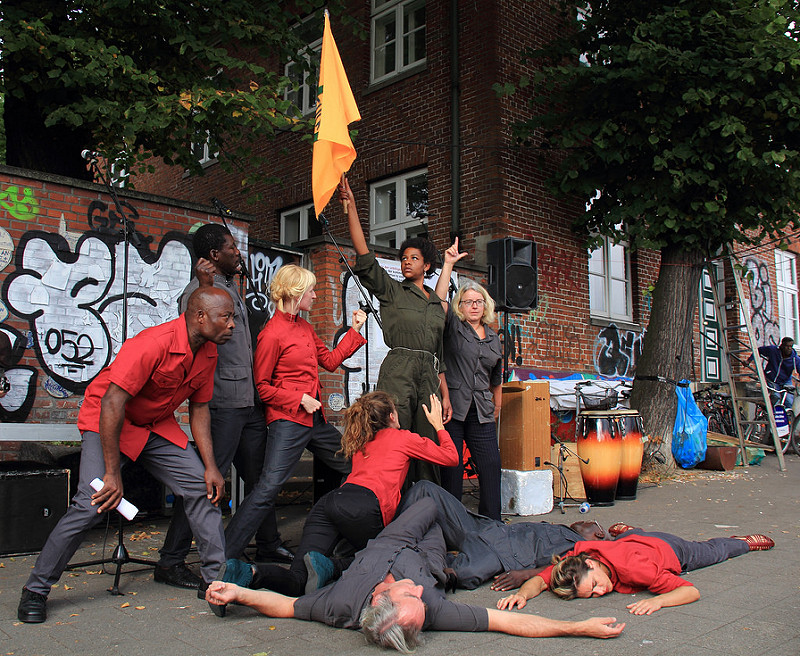
Schwabinggrad Ballett - platz der unbilligen lösungen II
Photo: Rasande Tyskar via VisualHunt / CC BY-NC
EU calls on the arts to empower and integrate refugees
The UK and Poland were the only EU countries that didn’t contribute to a major new report on how arts organisations and policy makers can help migrants.
Cultural institutions across Europe should create new museums and exhibitions dedicated to migration, as arts and culture are “uniquely placed” to empower refugees, a major new European Union (EU) report has concluded.
It also advises policy makers to prioritise funding for arts projects that integrate migrants, and cultural bodies to make their recruitment practices more open to people from different backgrounds.
“Culture is an opportunity to create links, to bring newcomers together with native populations and longer-term migrants from different backgrounds,” the report, which is dedicated to murdered MP Jo Cox, says.
“It is a powerful means of promoting openness to others, sharing emotions and happiness.”
Cross-European project
The report has been produced by an EU working group on “intercultural dialogue in the context of the migratory and refugee crisis”, which comprises Norway, Iceland, and all EU member states except Poland and the UK.
Written during the refugee crisis in 2016 – although before recent terrorist attacks and the Brexit vote, which are credited with making Europeans more reluctant to welcome refugees – the report assesses how culture can bring people together and increase participation in societal life.
It offers recommendations on intercultural dialogue for cultural policy makers and institutions, finding arts projects that give people the chance to share concerns and lead arts activity are the most empowering.
The report calls on policy makers to support and fund networking, self-organisation and active participation programmes, and to be sensitive to the different needs of individuals and groups, including those experiencing disadvantage or discrimination.
“How migrants are treated by arts and cultural institutions can also be a good indicator of how minority groups are treated more generally in host societies,” the report adds.
Working collaboratively
The report notes successful integration for refugees is dependent on many factors – including housing, education, language skills and jobs – and concludes artistic or cultural projects should focus on “intersectoral” connections.
The report says: “Where there are so many interdependencies, the role that art and culture – how valuable they are for their own sake – should not be considered on its own.”
It advises arts organisations to be more “interculturally aware” in community outreach, to develop quality data on audiences, and to consider cooperation with external authorities, working in fields such as education or social employment.
In addition, the report stresses the need for a “deeper” evaluation of funded projects, beyond financial and quantitative measures, to effectively assess societal impacts. 46 case studies are appended to the report in support of this, such as Antwerp-based organisation KunstZ’s work in providing education, guidance and support for artists to increase employment opportunities for migrants in the Flemish cultural sector.
Elena Polivtseva of Brussels-based IETM (International network for contemporary performing arts) praised the cross-sector approach in the report as “key for empowering the art sector to achieve tangible results” in helping newcomers integrate into European societies.
But she called on the EU to strengthen the support it provides to arts professionals working on migration. “The report refers to the Creative Europe call for projects aimed at supporting refugees’ integration. Unfortunately, only a small budget had been allocated for this call, and only 12 projects from 274 submitted applications were selected,” she said.
“Small-scale local projects and small organisations, which are short of resources to handle a complex application process, are very often the ones most involved in the work with the recently displaced. A more varied approach is crucial, and EU funding should be more flexible and accessible for micro-organisations and small-scale initiatives.”
She added: “Better synergies with other EU programmes and a clear and effective communication of all existing funding opportunities would help art professionals access multiple existing funds, be able to make their projects sustainable and even more impactful.”
Join the Discussion
You must be logged in to post a comment.